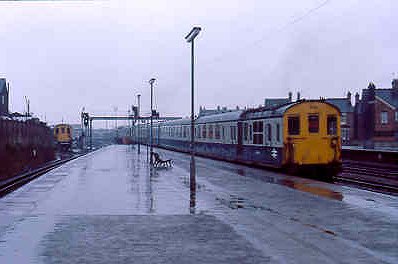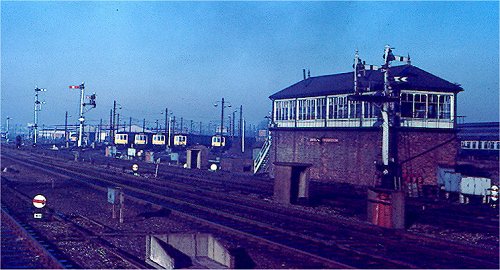Working the DMUs by Arno Brooks
A Southern Diesel Multiple Unit and a memorable old boy
When people think of great cab rides they usually think of Deltics, Westerns, Class 87 electrics etc. One of my most memorable rides was in a southern DEMU.
One day I relieved a freight train from Brent Junction and worked it as far as Hither Green. I believe that it was going to Dover. From Hither Green the guard and I were to travel back to Charing Cross and then make our way back to Cricklewood. Before long we had caught an old 4 EPB unit to Charing Cross. It was about 11am on a pleasant spring day in 1979. I noticed that in a few minutes there was a train for Hastings. I had often seen the strange narrow bodied 6 car 6L diesel electric units that ran from Charing Cross to Hastings. Here was my chance to have a ride on one. The old BR was very inefficient, once I had departed Cricklewood with that freight train nobody really expected me back that day. It was a skivers paradise. Today the private train operators make sure they get their monies worth out of each driver. Then, if you were a driver on the system you were more or less welcome in the cab of any BR train. On road learning days I often swanned off to all sorts of different places. Once I actually rode all the way from Euston to Carlisle and back.
I walked to the cab of the 6L unit. The elderly driver was looking back out of his side window. He looked remarkably like the late Field Marshall Bernard Montgomery. I said that I was a Cricklewood driver and could I come for a ride to Hastings. “Corse yer can son, get in.” I liked him instantly. Off we went. The 6L was a fascinating experience. Behind the cab was a gangway and behind that was the door to the engine room. Inside was a medium sized four cylinder diesel engine and main generator set and all the gubbins usually found in a proper diesel electric loco. The engine was the same type as a class 73 electro diesel. The diesel engine thumped and whistled as we rattled, bounced and swayed through Kent. Top speed was 75mph but at times we went at well over 80mph on various downhill bits. This was the best DMU I had ever been on. It actually made the job fun.

A six car Hastings Diesel Electric Multiple Unit at Tonbridge. Spring 1979. Arno Brooks.
The driver was close to retirement and had originally started at Brick Layers Arms shed in Battersea, south London. He had been a fireman all through the war and told me all about firing Schools class and King Arthur class locos on expresses through the war. He fired passenger trains in and out of Charing Cross and London Bridge during the blitz. I wish men like him had written down their memoirs. They would have made terrific reading. He was a great old boy. A real cockney of the old school. The trip to Hastings and back to Charing Cross was over all too quickly. Many times in the early seventies I met drivers of his generation. I used to get them to talk about their early days. In their youth they had had it really tough and the war strained them to the limit. There was something indefinably experienced and reassuring about them. They were deeply professional and I admired them greatly. We have good drivers today but those old boys stand head and shoulders above anyone driving today. Sadly nearly all of them will now have passed on.
Stranded in the frozen wastes of North London
In the last 30 years I haven driven over many remote and exposed stretches of railway. Only once have I been stuck in a snow drift. Where? In a bridge under Highgate Road, London NW5 in a 3-car 116 set.
I was driving the last train of the night from Barking to Kentish Town. It was mid-January 1977 (I think). It had been snowing for several hours. During the evening the wind had picked up and by about 10.30pm it was a real blizzard. There was only an hourly service over that line at that time of night and the snow had begun accumulate. The previous station was Upper Holloway. I had been getting worried about the snow. After terminating at Kentish Town we were scheduled to run empty to Cricklewood. I would then ride home to Kentish town on my motorbike. Motorbikes and snow don’t mix (as far as I’m concerned).
I was running at about 30mph when the unit entered a cutting as the line curved round to the left. Ahead the cutting was very full of blown snow. I opened the throttles to try and force the unit through the cutting. The speed dropped and the unit was stuck fast on a tight curve in deep snow. Despite my best efforts we would not budge. Not far away was Junction Road Junction signal box. I managed to walk to the box. There I phoned the Midland lines controller. The whole region was getting clogged up with snow, the last thing they were interested in was my humble DMU. I was told to shut down the engines and leave it and get home by whatever means available. Luckily the guard, our solitary passenger and I all lived within a mile. We all walked along the track to the signalbox, up the stairs and out to the street and home.
Sombreros and plastic donkeys
Suburban passenger work tends to be pretty free from memorable events. Then as now you can embark on a long passenger journey and absolutely nothing interesting happens. This is where Luton became such an oasis in a desert of eventlessness. In the ‘70s charter air travel to Spain took off in a big way and Luton Airport was one of the main airports. Today people are nonchalant about flying to Spain. In those days it was terribly exciting. You could instantly tell at St Pancras or Bedford which passengers were for Luton Airport. Many just had to tell anybody, even the train driver that they were off to Torremolinos or Benedorm. They were often bouncing with sheer excitement. On their way home after their Spanish holiday they were to be seen waiting at Luton. Even if it was the middle of winter many were still wearing Hawaiian shirts or tank tops. Yes, many would be wearing sombreros and carrying plastic or straw donkeys. In the messroom at Cricklewood we had several of these mementos that passengers had disguarded as they sobered up. At Cricklewood could be seen the uncanny sight of an elderly Caribbean gentleman man fuelling DMUs whilst wearing a sombrero.
Let naturism take its course
Cricklewood BR depot and yards lay adjacent to the Edgware Road in North London. Across the road was Cricklewood Bus Garage and the notorious Cricklewood Club. There BR and London Transport bus staff would gather, drink and create all types of lunacy. One night at about midnight I was sitting in a DMU waiting in the queue for it to be fuelled before going in for its nightly repair session. As usual I was reading the Daily Mirror. When working on the depot we used to wear a dark blue cotton smock to keep our uniforms clean. It was officially called a dust coat. Suddenly there was a loud bang on my cab side window. Someone had thrown a piece of ballast. Standing on the ground below was a stark naked Welshman. He was one of our drivers and well known for his crazy antics in the Cricklewood Club.
Me. “What the **** are you doing?”
Welshman. “Brooksie boyo, lend me your dust coat.”
Me. “Yeah OK, what’s happened to you?”
Welshman. “Not a lot, fairly quiet evening really.”
Me. “OK, here’s my coat but I want it back tomorrow.”
Welshman. “Thanks Brooksie you’re a champion.”

A general view of Cricklewood. Note the old Midland Railway Cricklewood Junction signalbox. To its left are the DMU sidings and further left in the distance is Cricklewood Loco depot. About 9.00am on a January morning 1975. Arno Brooks.
Kentish Town
Kentish town in the London Borough of Camden is a place that features largely in my private life and also in my railway career.
Kentish Town station was my local station. During the seventies and early eighties when I knew it, it had a very strong Victorian atmosphere to it. It lay in a deep, wide brick cutting. High above, the cutting was crossed by six red brick, road bridges that were streets of Victorian Town houses. All around, from above, houses looked down on the station. Although it was surrounded by bustling north London it was quite remote from its surroundings. Although Kentish Town had been bombed during the war the railway remained largely intact and in Victorian condition. Through the cutting ran six tracks. Four up and down lines to St Pancras and the two City lines that led to the underground Metropolitan Widened Lines and Moorgate. Kentish Town station was a typical Victorian urban station. The large brick and wood booking hall was at street level. To reach the platforms the public went down wide, covered, wooden, glazed staircases to the platforms. The platforms were islands and had long, wood, iron and glass canopies. One of the platforms had a series of single story brick and wood buildings that were waiting rooms and various station staff rooms including a traincrew mess room.
The place had a unique atmosphere, especially on hot summer days. Everywhere was grimy red brick and the area became very warm in sunshine. The station buildings and bridges cast deep black shadows and the area always had a smoky, almost subterranean atmosphere. It was very easy to stand on the platforms and imagine the Victorian days when Johnson single wheelers came blasting through hauling rakes of beautiful panelled maroon clerestory coaches. When I knew the place it was host to roaring class 45 Peaks hauling blue and grey Mark ones. Also the place rattled with class 25s running between St Pancras and Cricklewood with empty coaching stock. And, of course lots of DMUs.
Kentish Town was the terminus of the old Midland suburban route to Barking. The twice hourly service of Class 116 units would arrive at Kentish Town. When empty of passengers, the driver would propel the set another quarter mile along the cutting to a ground frame where the guard would operate the point levers. The set would then reverse from to Up City line to the Down City line and return to Kentish Town for the next run across north east London to Barking. There were frequently one or more sets of DMUs idling in the station adding to the smoky atmosphere.
Today all the buildings have been demolished. In their place are a few inadequate bus shelters. Midland Mainline HSTs and Thameslink EMUs thrash through there every few minutes, a few of them stop there. The Kentish Town station that I knew may have been tatty, grimy and a bit leaky but it had a dignity and character that cannot be replaced by contemporary buildings. Now it is just another naff has-been with graffiti and lager cans. The Victorians left us wonderful old stations. British Rail just wasted them. Virtually all are now just faded memories.


